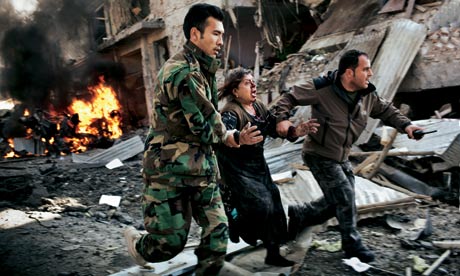Photo by Adam Ferguson
After reading an article at the Guardian about war photography, my trials and tribulations of trying to be in the NYC art scene feel so insignificant. Read here. (warning: very disturbing photos)
In terms of cultural production and commitment to the human race, are the goals and affect of these works more important and more effective than that of works in the fine art sphere? Bradford's beautiful collages reference issues of class and urban issues, but do they reference those issues in a productive way or to the right audience? Could these photos of war be considered 'art' and would naming them as such make them more powerful?
Photojournalists are risking their lives or safety so that we can know what is happening around the world, Maybe we don't need another intense performance artist whose masochistic works aim to make us think about bodily harm, pain, and suffering, there is already enough to go around. If artists who are proposing alternatives to capitalism, confronting tyranny, promoting socialism, as many social practice/relational aesthetic artists claim, wouldn't they be better servicing society by being photojournalists, politicians, or social workers? These photos have real artistic merit, but somehow are unwelcome in the gallery scene.
Photographers Tim Hetherington and Chris Hondros were killed earlier this year while documenting the uprising in Libya. Would we have cared about the uprisings without journalists like these? Tweets, facebook events, and amateur photos/videos are crucial, but maybe without artful documentation, would we care as much?
Photographers Tim Hetherington and Chris Hondros were killed earlier this year while documenting the uprising in Libya. Would we have cared about the uprisings without journalists like these? Tweets, facebook events, and amateur photos/videos are crucial, but maybe without artful documentation, would we care as much?
Alfredo Jaar, detail shot of the Rwanda Project

Installation shot, from here
Artists acting as journalists. Alfredo Jaar takes his work a step towards art by making a very aesthetic installation of photographs Rwandans eyes, after the Rwandan Genocide. This moving installation, a combination of photojournalism and art, might be the best of both worlds. To be a good citizen one must know what is happening, know who to vote for, how the stocks are doing, and what is happening in their area. People don't usually go to museums think about the news, but Alfredo Jaar's work could help change that. By making immense and emotional connections to the news, his work counters the commonly overwhelming news field that nourishes disconnect, instead of empathy and understanding.

Fred Wilson, Metalwork, image from here
Nothing to do with photojournalism, but everything to do with bringing political questions into the museum context. Fred Wilson's process of 'Mining the Museum', blurs the line between a history museum and an art museum. His famous installation, Metalwork, juxtaposes ornate silver vessels with slave shackles from the same era and area. Metalwork asks crucial questions about the museum as an institution to produce culture and history. How should a museum show history? Who decides which history to show? In Metalwork, Wilson subverts standard display rules by simply adding a larger context.
What I am suggesting is that art does not have to shy away from being educational and in dialogue with the news. There is no reason why history, politics, journalism, and aesthetic sensibility cannot mix.


No comments:
Post a Comment